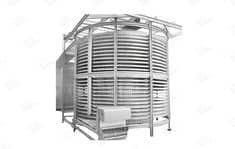What Is the Function of a Spiral Freezer?
There are many different types of freezers on the market, and understanding how they function will help you choose the best one for your needs. Understanding how a Single Spiral Freezer or an IQF tunnel system works can assist you in making an informed decision.

Source: https://i.pinimg.com
Temperature Control
A spiral freezer rapidly decreases the temperature of products, preserving their texture and moisture. Its quickness also prevents huge ice crystals from accumulating on packaging.
To remove heat from the product, a standard Fluidized Bed Freezer employs a cryogenic refrigerant such as liquid nitrogen, liquefied carbon dioxide, or solid carbon dioxide. It is used to freeze, chill, or proof things like as meat, poultry, prepared dishes, baked goods, and ice cream.
Because carbon dioxide is a denser gas than room air at -80 degrees Fahrenheit, existing spiral freezers that use liquid carbon dioxide as the cryogen lose the most significant amount of refrigeration from cold gas overflowing out of the lower aperture.
Existing spiral freezers use an enlarged exhaust fan and an exhaust cowl at the lower opening to prevent carbon dioxide gas from collecting in the processing room, reducing this loss. This strategy, however, has lots of disadvantages.

Source: https://i.pinimg.com
Conveyors
Double Spiral Freezer use spiral-shaped belts to transport food from an infeed part to an outfeed section. These belts are intended to shorten freezing durations while maintaining product quality, resulting in a more efficient and effective frozen food manufacturing line.
Conveyor belts for spiral freezers must be capable of traveling a linear infeed course where fresh food products are deposited onto the conveyor belt’s food product supporting surface, followed by an arcuate helical freezing course where the conveyor belt’s food product supporting surface turns laterally. To permit the curved helical freezing course on a collapsing conveyor belt, the food product supporting surface portions must rotate or shift toward adjacent rods.
Spiral freezers can be outfitted with modern monitoring and controls to improve product temperature management while lowering energy usage and increasing plant efficiency. The controls can be linked with the primary refrigeration and process equipment control systems, allowing them to update parameters automatically based on the products being produced.
Condenser Coils
A continuous freezer’s condenser coil takes heat from the air. The condenser coil should be placed in a well-ventilated, temperature-controlled environment where heat may be easily removed.
The condenser coil, in addition to eliminating heat, is a primary source of energy for the refrigeration system. The condenser coil should be cleaned on a regular basis to prevent dust and debris from clogging the airflow and causing excessive energy consumption or compressor failure.
Spiral freezers commonly use both nitrogen and carbon dioxide cryogens, however due to its fast refrigeration value, LN2 is the favored choice for food manufacturers. Nitrogen is fed into a belt-shaped tunnel, and cold vapor is blasted over the product by large fans on the belt’s outside borders.
As a result, food products are transported through the spiral freezer at lower temperatures and with less cell damage than those transported via a linear tunnel freezer. As a result, the chilling and freezing times are reduced, and the yield is increased.
Energy Efficiency
Spiral freezers are a necessary piece of equipment in many industrial and manufacturing settings. Improving their efficiency has the potential to save industrial enterprises a significant amount of money in the long run.
A spiral freezer’s energy consumption can be lowered by lowering the fan speed, evaporator capacity, and airflow pattern. This can lead to significant operating savings and lower utility expenses.
However, depending on their size and application, the performance of these freezers can vary. As a result, it is important to choose a unit that can suit your specific requirements.
A computer-based control system should be included in the design of a spiral freezer. These systems can display product temperatures, fault states, and freezing durations, as well as provide datalogging and trending capabilities, allowing operators to monitor and control their equipment in a more efficient and precise manner.


